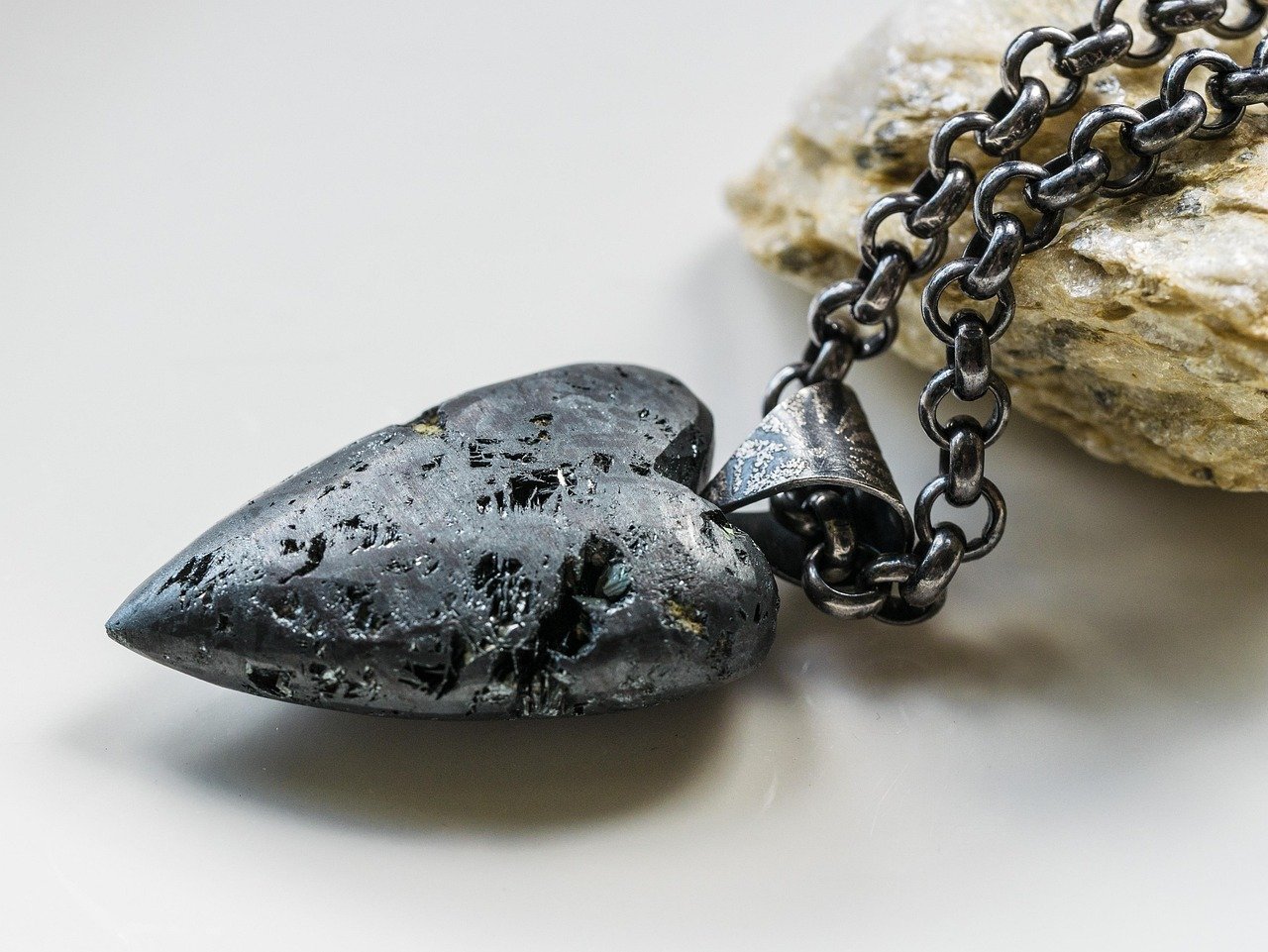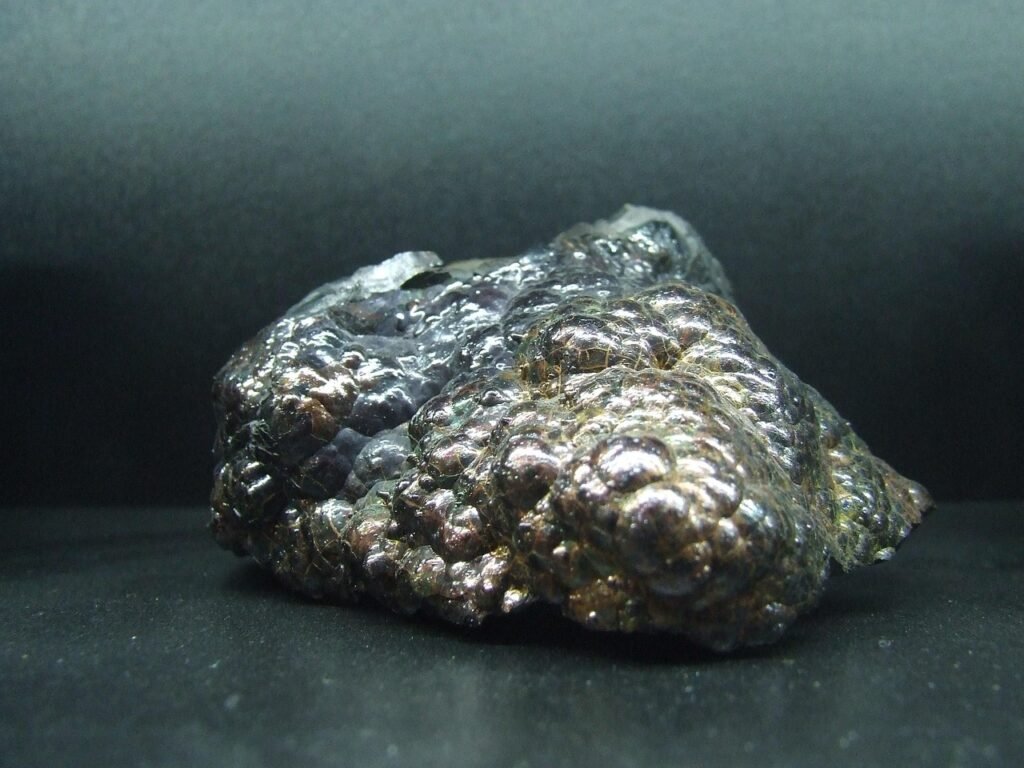What is Hematite?
Hematite Gemstone is a naturally occurring iron oxide mineral (Fe₂O₃) celebrated for its striking metallic luster and deep grey to black color. Known by names such as hematite stone or hematita, this powerful mineral boasts a rich iron content that gives it grounding and protective energy. It has a Mohs hardness of 5.5 to 6.5, making it relatively durable and suitable for various jewelry types. Hematite is commonly found in polished forms like beads, rings, and cabochons, as well as in its raw, earthy state. Revered in both ancient cultures and modern crystal healing, hematite continues to gain popularity for its unique aesthetic and metaphysical properties.

The History and Symbolism of Hematite Gemstone
The story of hematite crystal spans thousands of years, from ancient Egyptian amulets to Roman warrior shields. In ancient times, this stone was believed to offer strength, courage, and protection. It was often used in rituals and carved into talismans. In the Victorian era, polished metallic hematite became a favorite in mourning jewelry due to its reflective surface and grounding energy. Today, hematite gemstone is appreciated not only for its historical symbolism but also for its ability to bring balance, protect the aura, and enhance mental focus.
Hematite Meaning: A Stone of Balance and Clarity
The core hematite meaning revolves around grounding, protection, and mental clarity. It is considered a powerful root chakra stone that anchors the soul to the earth, making it ideal for people who feel overwhelmed, anxious, or emotionally scattered. By fostering inner strength and stability, Hematite Gemstone helps promote logical thinking and decision making. It is also a favorite among those seeking to boost confidence, dissolve negativity, and remain focused in high stress situations. These qualities make hematite a staple in energy healing and personal development.
Hematite Colors and Physical Appearance
What color is hematite? Typically, hematite appears in a metallic grey to deep black tone when polished. However, its powdered or streaked form reveals a reddish brown hue, hinting at its iron-rich composition. This red streak is often used to verify its authenticity. Raw hematite may display earthy tones with a slightly rusty surface, while tumbled hematite stones shine with a smooth, reflective finish. The visual contrast between raw and polished forms makes hematite both a collector’s gem and a decorative mineral.
Common Uses of Hematite Stone
Hematite serves a wide variety of purposes, ranging from spiritual protection to stylish adornment. In holistic practices, it is commonly placed in meditation spaces or carried in pockets to encourage calmness and mental balance. Hematite jewelry, especially bracelets and rings, is used to protect against negative energies and maintain emotional stability. It’s also employed in body placement for grounding and detoxifying the aura. Furthermore, the stone is included in crystal grids, healing layouts, and even home décor to create a peaceful and balanced environment.
Healing Properties of Hematite Crystal
The healing properties of hematite are deeply rooted in its grounding energy and connection to the root chakra. This powerful stone is known to:
- Improve focus and concentration
- Absorb negative energies and reduce anxiety
- Enhance blood flow and support the circulatory system
- Strengthen the will and boost self-confidence
- Encourage emotional stability during stress These holistic effects make hematite crystal a top choice for energy healers and spiritual seekers alike.
Is Hematite Magnetic?
While often marketed as a magnetic stone, pure hematite is only weakly magnetic or not magnetic at all. Many magnetic hematite bracelets and accessories found in stores are actually made from synthetic materials like hematine or ferrite. These imitation stones offer the same aesthetic appeal but differ in composition. To distinguish real hematite, conduct a streak test genuine hematite will leave a reddish brown streak on unglazed ceramic. It’s essential to be aware of these differences when shopping for authentic hematite jewelry.
Hematite as a Birthstone and Zodiac Stone
Though not an official monthly birthstone, hematite stone holds strong zodiac connections, especially with Aries, Capricorn, and Scorpio. Its grounding properties resonate deeply with these signs, promoting resilience, protection, and determination. Wearing hematite rings or carrying tumbled stones can help individuals of these signs stay emotionally grounded and mentally focused. In crystal birthstone collections, hematite is often recommended as a supportive ally for strength and self-mastery.
Types and Forms of Hematite Gemstone
Natural Hematite
Natural hematite is the most common and widely recognized form, often found in massive or botryoidal structures with a metallic gray to silver-black sheen. This type of hematite crystal is known for its high iron content and strong grounding energy, making it popular in spiritual practices and energy healing. Natural hematite is often used in bracelet hematite, hematite bead necklace, and raw healing stones. It exhibits a strong metallic luster and may appear glittery when finely crystalline. Black hematite is often a name used interchangeably with this form due to its deep, glossy appearance.
Magnetic Hematite
Magnetic hematite, sometimes referred to as “hematine,” is often synthetic and fused with magnetite or other magnetic materials to create attractive jewelry and healing tools. Though it mimics natural hematite magnetic qualities, true hematite is only weakly magnetic. Magnetic forms are popular in men’s hematite bracelets, magnetic necklaces, and therapeutic rings. Many users report that hematite magnetic jewelry helps with circulation, joint pain, and energy alignment. It’s important to note the distinction between real hematite and synthetic magnetic versions when shopping.
Tumbled Hematite Gemstone
Tumbled hematite stones are polished for smoothness and shine, making them ideal for carrying in pockets or placing in crystal grids. These are highly sought-after in metaphysical circles for their spiritual properties of hematite, such as grounding, protection, and energy balancing. Tumbled stones are widely used in hematite jewelry, especially hematite rings and worry stones, due to their gentle touch and attractive shine. The healing qualities of hematite are amplified in this form due to its accessibility and user-friendly nature.
Raw Hematite
Raw hematite is appreciated by collectors and crystal healers for its unaltered, earthy energy. This type can vary in appearance from metallic hematite surfaces to oolitic hematite, which resembles tiny rounded grains. Raw specimens can be used in spiritual rituals and are believed to connect more strongly with the Earth. In raw form, hematite stone benefits include detoxification, grounding, and enhancing mental clarity. It is often used in crystal elixirs (non-ingested) or meditative practices to connect with root chakra energies.
Hematite Quartz
Hematite quartz, or “Harlequin quartz,” features clear or rose quartz with shimmering hematite inclusions, creating an ethereal appearance. This unique form combines the metaphysical properties of hematite with the emotional healing of quartz, making it a favorite for advanced crystal healing. It supports both emotional grounding and spiritual upliftment, aligning the heart and root chakras. Many crystal enthusiasts believe that hematite quartz bridges the gap between logic and love, clarity and stability. It is rare and often found in high-end collections or crystal healing sets.
Oolitic Hematite
Oolitic hematite forms in spherical grains called ooids, often cemented together into sedimentary rock. Found in regions like Missouri and Kentucky (hematite lake KY, hematite Missouri), this form is less metallic and more earthy in appearance. Historically, Native American hematite Indian artifacts were crafted from this type due to its workability and spiritual significance. Its matte finish and natural form make it popular in earth-centered practices, connecting deeply with ancestral and geologic energies.
Colored Hematite Gemstone
While black hematite is the most popular, colored hematite varieties such as red hematite, metallic silver, and hematite red offer aesthetic diversity and distinct energies. Red hematite is associated with the root chakra, enhancing strength and survival instincts. Some dyed or heat-treated versions are used in artistic jewelry hematite pieces, like necklace hematite or vibrant bead strands. Colored hematite also appears in metaphysical stores as an alternative healing stone for energy work, with color influencing the type of healing support.
Hematite Gemstone Concretions
Hematite concretions are rounded, mineral rich nodules found in sedimentary rock layers. These rare formations have been discovered on Earth and even on Mars, sparking scientific interest. On Earth, they’re often collected for both their spiritual meaning of hematite and geological curiosity. Concretions symbolize centeredness and grounding and are often used in spiritual hematite practices to establish core strength and emotional balance.
Spiritual Properties and Chakra Healing
Hematite metaphysical properties are strongly associated with the root chakra, located at the base of the spine. This stone stabilizes energy, builds courage, and connects the user to the present moment. It is often paired with stones like black tourmaline or smoky quartz for enhanced protection. When used in meditation, hematite promotes stillness, clarity, and energetic alignment, making it a valuable tool in both beginner and advanced spiritual practices.
Hematite Jewelry Styles and Uses
Hematite jewelry seamlessly merges beauty and functionality. Its metallic luster makes it a popular choice for rings, bracelets, and necklaces. Men’s hematite rings and women’s hematite bead necklaces are particularly trendy for both their style and grounding effects. Since hematite can be brittle, it is best suited for cabochon cuts or beaded designs. Remove your hematite ring before engaging in heavy duty tasks to prevent scratching. Whether in the form of a bracelet or a pendant, hematite elevates both fashion and personal energy.
Hematite Stone Price Guide
One of the most accessible gemstones, hematite is prized for its affordability and elegance. Tumbled hematite stones can cost as little as $3 to $10, while premium hematite rings and beaded jewelry may range from $20 to $150, depending on craftsmanship and authenticity. Raw hematite and rare formations like oolitic hematite can attract collectors at higher prices. Magnetic versions are generally cheaper due to synthetic materials. Always check for genuine properties like the red streak to ensure you’re buying authentic hematite stones.
Raw vs. Tumbled Hematite Gemstone: Which is Better?
Both raw hematite and tumbled hematite offer unique benefits. Raw forms are powerful grounding tools used in altars, feng shui placements, and energetic cleansing rituals. Tumbled stones, with their smooth and shiny surfaces, are ideal for carrying, pocket use, or placing under pillows. Whether used in a bracelet hematite design or as a meditation aid, both types offer exceptional grounding and balancing properties to support emotional and spiritual well-being.
Is Hematite a Good Gemstone for Jewelry?
Absolutely! Despite its slightly lower hardness, Hematite Gemstone makes an excellent gemstone for jewelry due to its unique metallic shine and symbolic value. It is especially popular in beaded bracelets, cabochon rings, and layered necklaces. Its elegant black-silver tone makes it easy to pair with other gemstones like onyx, garnet, or turquoise. However, since hematite gemstone can be brittle, it’s essential to handle it with care and avoid exposure to harsh conditions.
FAQs About Hematite Gemstone
Pure hematite is weakly magnetic at best. Strongly magnetic stones are usually synthetic hematine.
Hematite provides grounding, clarity, emotional balance, and increased focus.
Use a soft cloth and mild soap. Avoid chemicals and hard brushes to prevent scratches.
Yes, its grounding energy helps calm the mind and release negative emotions.
The root chakra. It anchors energy, stabilizes emotions, and boosts resilience.
Scratch it on unglazed ceramic a red streak indicates genuine hematite.
Yes. Its bold color and grounding symbolism make it popular in men’s rings and bracelets.
Yes, it complements grounding stones like black tourmaline and smoky quartz.
Tumbled hematite under the pillow can promote restful sleep and energetic grounding.
Yes, but remove during intense activity to avoid damage due to its brittleness.
Final Thoughts
Hematite is more than just a visually stunning gemstone it’s a powerful ally for grounding, emotional balance, and spiritual growth. From hematite bracelets to hematite rings, this versatile stone bridges fashion and metaphysical function. Whether you wear it daily or use it during meditation, hematite strengthens your connection to the Earth and helps you remain centered amidst chaos. Affordable, attractive, and energetically potent, hematite gemstone is a must-have for crystal lovers and spiritual seekers alike.






